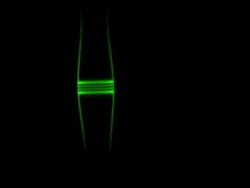Light captured in fiber oscillates in longitudinal direction
| In a glass optical fiber, light is captured in a bulge in the fiber. It can't escape because the diameter of the fiber decreases on both sides. (Image: TU Vienna) |
Vienna, Austria--While light waves normally oscillate perpendicular to their propagation direction, scientists of the Vienna University of Technology (TU Vienna) are now performing atomic-physics experiments using light that oscillates in the longitudinal direction.
To do this, they first couple light into a glass optical fiber in such a way that it spirals around the fiber in a bulged section. In such a "bottle" microresonator, light can be stored for about 10 ns, corresponding to 30,000 revolutions around the fiber. This is long enough to enable evanescent interactions between the light and single atoms, which are brought very close to the fiber surface.
Related: Researchers produce tunable, small-volume light storage device by stretching optical fiber
The TU Vienna researchers have discovered that in this situation, light and matter couple much more strongly than previously expected. This surprising result stems from an exceptional property of light inside such microresonators: It oscillates in the longitudinal direction.
Cycloidal oscillation
Light waves can oscillate in a fixed direction (linear polarization) or twist like a corkscrew (elliptical or circular polarization). However, for plane light waves, this oscillation is always transverse (perpendicular to its propagation direction). However, the light confined in the TU Vienna bottle microresonator also has a longitudinal component, oscillating along the propagation direction.
"Thus, the light wave rather resembles the rotor of a horizontally flying helicopter,” says Arno Rauschenbeutel, one of the researchers. While the tips of an aircraft propeller trace out a corkscrewlike path through space, the trajectories of the tips of a helicopter rotor describe a more complicated trajectory – a cycloid, he notes.
In the bottle microresonator, light can travel clockwise and counterclockwise around the fiber. If the polarization of the two counterpropagating light waves is merely transverse, they will enhance each other at certain locations while canceling out in other places. “It is this destructive interference which limits the coupling strength between the light waves and the atoms around the glass fiber,” says Rauschenbeutel.
But if the two light waves also oscillate along the direction of propagation, their oscillation states will inevitably differ. As a result, a complete cancellation of counterpropagating beams by destructive interference is not possible. This leads to the enhanced evanescent interaction with atoms.
A light router controlled by a single atom
Potential uses include sensors that can detect single atoms with light or aid in studying light-matter interactions. The researchers next want to create a router for light that is controlled by a single atom and switches light between two output ports. Such a quantum-mechanical router could someday be used for interconnecting future quantum computers in optical fiber networks.
Source: http://www.tuwien.ac.at/en/news/news_detail/article/8210/
